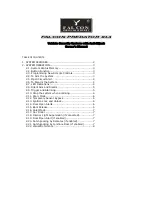
Page 9
NOTE:
The alarm horn loudness meets or exceeds current UL standards of 85 decibles at 10
feet (3 meters).
WEEKLY TESTING:
This alarm is designed to act as a monitor, not for use as a short-term
testing device, or to perform a quick check for the presence of CO or smoke. The built-in test
switch accurately tests the alarm operation as required by ANSI/UL 2034/UL 217 Standards
for Safety. If at any time the alarm does not perform as described when tested, replace it
immediately. Weekly testing is required to ensure proper operation. Irregular or low volume
sound may indicate a defective alarm and it should be returned for service. Follow deactiva-
tion instructions to prepare alarm for shipment or disposal.
NOTE:
Actuation of the test button must be by use of a person’s finger or thumb. Use of any
other instrument is strictly prohibited.
USING THE TEST FEATURE:
Press and release the Test button on the alarm cover. During
testing, the alarm will sound a loud horn pattern consisting of 3 beeps, followed by a 6 second
pause, then 4 beeps. The red smoke LED will blink in sync with the 3 beeps and the red CO
LED will blink in sync with the 4 beeps. The alarm will sound if all the electronic circuitry, horn
and battery are working properly.
If the alarm does not sound properly:
1. Hold the test button down longer. Try holding the test button down for up to 10 seconds.
2. Make sure the battery activation pull tab has been completely removed.
3. If there is still a problem, call customer service. Do not attempt to fix the alarm.
ALARM AND BATTERY DEACTIVATION
This alarm uses a sealed battery for power.
The battery should last for approximately 10 years under normal operating conditions.
Deactivation of the alarm is permanent.
Place this alarm into shut-down mode at the end of its useful service life. Once the alarm has
entered end-of-service-life mode, it is necessary to turn off the alarm to deactivate the alarm
operation. This will stop the product end-of-service-life warning signal and also discharge the
remaining capacity of the battery and ready the alarm for disposal.
1. Remove the alarm from the mounting bracket by rotating it in the direction shown the
arrows on the rim of the base.
2. The plastic alarm deactivation key is molded in the mounting bracket of the alarm. Refer to
Figure 3). Use a small flat blade tool to remove (breakaway) the deactivation key from the
mounting bracket.
3. Insert the key into the deactivation keyhole slot outlined on alarm label, and insert fully.
4. Slowly turn key clockwise to the “off” position, approximately 3/4 turn. Do not remove key.
5. This will discharge the alarm battery and stop the alarm chirping after approximately on
minute. The alarm is now ready for disposal.
6. The deactivation key should not be removed and the alarm cannot be re-attached to the
mounting bracket.
7. Be sure to install a new alarm immediately.
Once this alarm has been deactivated/turned off:
• The alarm cannot be re-activated
• The alarm cannot be re-attached to the bracket
• The alarm will no longer detect smoke or carbon monoxide
• The alarm contains no serviceable parts
DEACTIVATION KEY
FIGURE 3

































